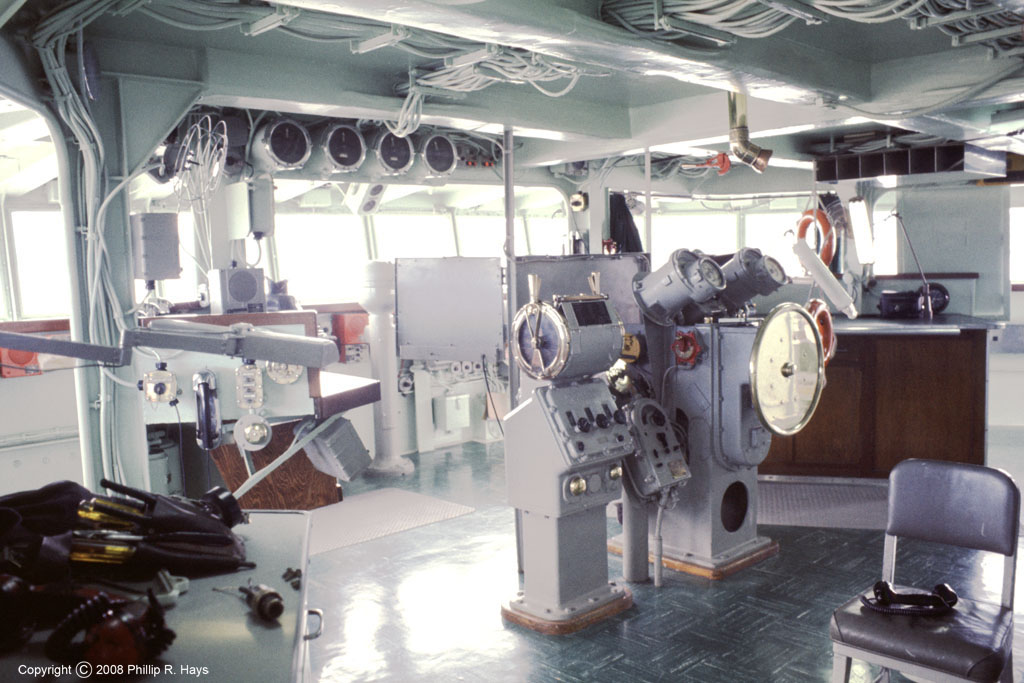
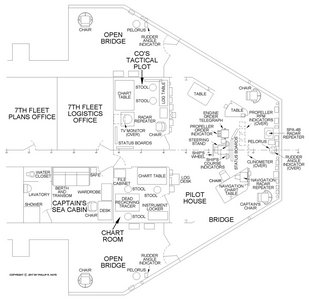
The ship was operated from the Bridge when it was at sea. It was on the O3 level (third deck above the main deck) at the forward end of the forward superstructure. This is where the ship was steered and where the navigation watch was located. The primary watch stations were on the Bridge and in the Pilot House. When the ship was converted to a guided missile cruiser in 1959 the Bridge and Pilot House were separate spaces, with a solid bulkhead between them. Also, at that time the bridge was open to the weather. But within a few years the main part of the bridge was covered and then fully enclosed to isolate it from the weather. Then the bulkheads between the Enclosed Bridge and the Pilot House were removed so the watch standers could move freely between the two spaces. Windows all around gave good views of the ship's surroundings.
The Captain or Commanding Officer (CO) was responsible for the ship and its crew. When the ship was at sea he was almost always on the bridge or nearby in his Sea Cabin where he slept and took his meals. The Captain appointed an Officer of the Deck (OOD) to actually drive or "conn" the ship and oversee underway operations. Often the OOD would be training a Junior Officer of the Deck (JOOD). Under some circumstances the Captain would "take the conn" to drive the ship.
The OOD normally conned the ship from the Bridge. He used the Pelorus or alidade (a gyro compass repeater that showed the ship's heading) on the ship's centerline to check the ship's heading. A Rudder Angle Indicator and Ship's Speed Indicator above the Pelorus allowed checking how the ship was maneuvering. A radar repeater could be used to check any of the ship's air, surface or navigation radars. The Bridge also had numerous phones, interior communications (IC) equipment, and radio handsets. During maneuvering, while along side a replenishment ship and going alongside a pier the CO and OOD might be on an Open Bridge wing where the view was better. Each Open Bridge had a Pelorus and Rudder Angle Indicator. Several voice tubes ran from the Helm and Lee Helm to the bridge, open bridges and a conning station on the open deck above the bridge on the O4 level. These were used if other means of communication failed.
The normal Condition IV (lowest state of readiness) free steaming watch included the OOD, a Helmsman, Lee Helmsman, Bosun of the Watch, Quartermaster of the Watch and a phone talker who communicated with the lookouts and the Combat Information Center (CIC). The phone talker also kept a status board up to date with information about surface contacts in the vicinity. When the ship was at General Quarters (Condition I, the highest state of readiness) there were many more people on the Bridge manning equipment, the Chart Room and the CO's Tactical Plot.
The Quartermaster of the Watch maintained the navigation plot. He had a navigation radar repeater at the Pilot House Chart Table and equipment in the Chart Room to check the ship's position. The Dead Reckoning Tracer (DRT) used course information from the ship's gyro compasses and speed information from the pit log (an instrument to measure the ship's speed through the water) to keep a running plot of the ship's position when there were no land falls to determine the position from optical sightings or navigation radar. The DRT could not compensate for water currents and winds, so it was not always accurate. The ship had a NAVSAT receiver that gave position information every 90 minutes from the Navy's NAVSTAR satellite system - an early "GPS." Of course, the Chart Room is where the ship's supply of charts was kept. The CO's Tactical Plot room was where the Captain could plan maneuvering during tactical situations.
The Captain and the ship's Navigator would determine the courses and speeds to take to get the ship to where it needed to go to carry out its orders. The courses would be marked on a chart that was kept on the Pilot House Chart Table. The Quartermaster periodically checked the ship's actual position with the desired course and made recommendations to the OOD for course and speed changes. A navigation watch in CIC double checked the ship's position and recommendations of the Bridge Quartermaster. The Bosun of the Watch on the Bridge recorded all course and speed changes, the ship's positions and changes of the watch in the ship's Deck Log. Any other ships in the area or unusual events were also recorded, such as injuries to the crew or casualties to the ship's equipment.
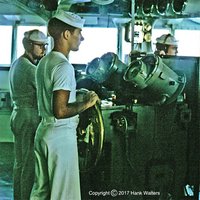
The Helmsman was stationed in the Pilot House at the Steering Stand (Helm) at all times when the ship was at sea. He turned the Ship's Wheel to change the rudder position and keep the ship on the course ordered by the OOD. To change course the OOD would say "Left (right) standard (full, hard) rudder. Come to new course NNN."The OOD could order specific rudder angles and course changes, such as "Come right ten degrees rudder" and "Steady up on course NNN." The Helmsman would repeat the commands and when the ship steadied up on the new course he would report "Steady on course NNN" and the OOD would reply "Very well." This protocol ensured that everyone heard the orders and replies. The Helmsman watched the Ship's Course Indicators and if winds or currents caused the ship to drift off course he turned the rudder to put the ship back on course. With very strong winds or in channels with strong currents the Helmsman would be busy keeping the ship on the ordered heading.
Normal maneuvering used fixed rudder angle increments, such as "standard," "full" and "hard" or "hard over" to cause the ship to turn more or less quickly. For most course changes we used "standard" rudder which caused the ship to come about to the new course relatively slowly, but it caused the ship to roll at a smaller angle. "Full" and "Hard" rudder cause sharper turns, but also caused greater roll. During course changes the ship rolled to the outside of the turn, and the faster the ship was moving the greater the roll angle. The Oklahoma City was fairly top heavy and tended to roll quite a bit. Sudden sharp rolls could cause people and equipment to go sliding across decks and cause damage, so large rudder angles were used only in emergencies or at very slow speeds. We had a Clinometer (inclinometer) overhead immediately behind the centerline Pelorus so the OOD could check the roll angle. The maximum roll angle the ship could take was 35° - beyond that the ship could roll over and "turn turtle." This was considered a bad thing to be avoided.
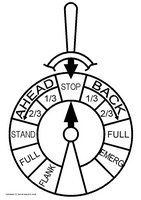
The Lee Helmsman was stationed at the Engine Order Telegraph (EOT) and sent the OOD's speed orders to Main Control in the engine room. The EOT, or sometimes called the Lee Helm, was the normal way the ship's speed was controlled. It was a cylindrical housing on a pedestal, with a handle and a dial face on each side. The handle rotated around the center of the dial, and had a pointer to indicate specific positions on the dial. The dial face had positions corresponding to standard engine speed orders for steaming ahead and back (reverse). The handle on the left side controlled the two port engines, and the handle on the right controlled the two starboard engines. Four Propeller RPM Indicators were mounted overhead in front of the EOT so the Lee Helmsman could check the actual engine speeds. The Lee Helmsman manned the EOT at all times when the ship was at sea.
When the OOD gave an engine order, say "All ahead full," the Lee Helmsman repeated the command and rotated both handles to the Ahead Full position. This rang a bell at Main Control in the engine room. The watch in the engine room had a similar EOT, and they rotated their handles to the Ahead Full position. This rang a bell on the Bridge EOT and the arrow in the center of the dial rotated to the Ahead Full position. The Lee Helmsman reported "Engine room acknowledges all ahead full" and the OOD replied "very well." The engine room watch then adjusted steam flow to the turbines to attain the ordered speed. Engine speed orders were normally given in standard increments such as "Ahead one third" or "Ahead flank" that corresponded to specific engine speeds in RPM (rotations per minute of the propellers). One third would move the ship slowly and flank was an order to the engine room to give it everything they had for maximum speed (about 32 knots, or nautical miles per hour). "Back emergency" meant put the engines in reverse at the highest possible speed.
Sometimes it was desirable to operate the port and starboard engines at different speeds. For example, when pulling away from the pier in port it was often desirable to "twist ship," or cause the ship to rotate about it's center of gravity. To do this the engines on the side away from the pier would be run forward and the engines on the other side were run backwards. The rudder would be put hard over toward the pier side of the ship to help with the maneuver. This pushed the side of the ship opposite the pier forward while the side close to the pier tried to go backwards. The ship pivoted around the middle, pushing the bow closer to the pier and the stern away from the pier and any ships moored close behind. The outboard engine was usually run faster than the inboard engine to give the ship a bit of headway. But a mooring line (spring line) from the bow of the ship to bitts farther aft on the pier prevented the ship from moving forward and helped it pivot around the center. If the ship was moored between other ships at the pier, this maneuver would kick the stern out so the ship could then put all engines in reverse and the rudder amidships (centered) and pull away from the pier, missing the ship moored aft.
To make the ship turn faster in emergencies while the ship was underway the engines on the outside of the turn could be ordered ahead and the engines on the inside of the turn ordered to reverse. When the ship was standing still with no headway, twisting ship with engines ahead and back at the same speed would cause the ship to spin slowly around the center of gravity amidships. This procedure was used when calibrating the ship's compass by rotating the ship until the bow pointed at known landmarks and adjusting the compass so it read the correct bearings.
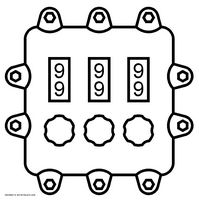
Speed adjustments with the EOT were fairly coarse. For fine adjustments of the ship's speed the Propeller Order Indicator (POI) or Engine Revolution Telegraph was used. It was positioned below and in front of the EOT, and had three knobs and three readout windows for setting exact propeller speed in RPM. The Lee Helmsman used the knobs to set a three digit propeller speed - the numbers appeared at the bottom of the windows. The engine room watch responded by setting numbers in another POI to match the engine order, and on the bridge the numbers set by the engine room appeared in the POI windows above the numbers the Lee Helmsman had set. The ship moved through the water at about one knot for every ten RPM. Top speed was 32 knots and that was about 320 RPM, although the speed to RPM relationship wasn't exactly linear.
Specific propeller RPM settings were used when the OK City was holding station on another ship in a formation or was alongside another ship for replenishment. During underway replenishment (UNREPS) the replenishment ship held a steady course and speed, but changes in wind and currents affected it's actual course and speed. The Oklahoma City's OOD watched the replenishment ship carefully, and added or subtracted one or two turns (RPM) as necessary to hold position alongside. The ships had a Distance Line running between them with colored flags every 20 feet, and the OOD would issue changes of course in one degree increments to maintain a constant distance between the ships. UNREPS could last for up to two hours, and all the time the OOD issued minute changes in course and speed to match the replenishment ship. This kept the Helmsman, Lee Helmsman and Bosun of the Watch (recording the course and speed changes) pretty busy.
The normal schedule was for four hour watches between 0400 (4:00 AM) and 2400 (midnight), with two two hour "dog watches" from 0000 (midnight) to 0200 (2:00 AM) and 0200 to 0400 (4:00 AM). The short dog watches ensured that the watch schedule "rotated" so no watch section would have the same watch hours day after day. A formal procedure was followed for changes of the watch. The oncoming OOD (Mr. A) would arrive on the bridge a few minutes early and familiarize himself with the current course and speed, the ship's position and what the ship was currently doing. He then addressed the OOD (Mr. B) and said "I relieve you sir." Mr. B then said "I stand relieved." Then to the watch crew he said "This is Mr. B, Mr. A has the conn." The other watch standers then acknowledges with "Aye, aye, sir." The other watch standers followed a similar procedure, but did not announce to everyone on the bridge when they exchanged duties.
Occasionally when going into a port or entering a river channel a Pilot would come aboard. He was very familiar with the channel and navigation hazards, and would take the conn in place of the OOD. However, the Captain still had the last say about how the ship was maneuvered and could take the conn at any time. The only time the Captain was not responsible for the ship was when it went into a dry dock. As soon as the bow entered the dry dock responsibility for the ship shifted to the dry dock commander. Of course, this didn't stop the Captain from worrying about his ship!
